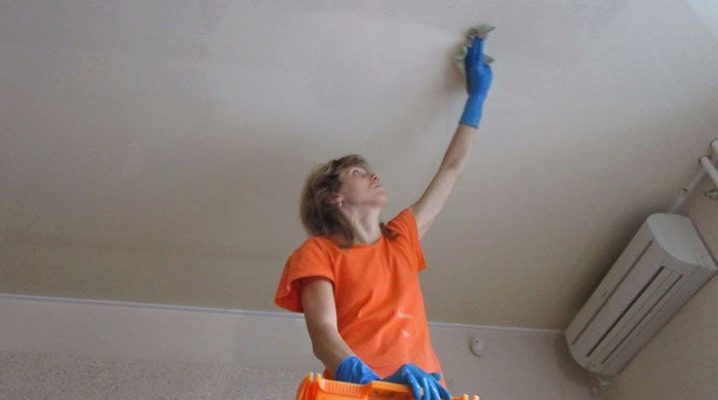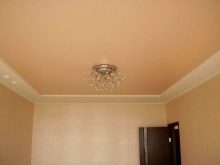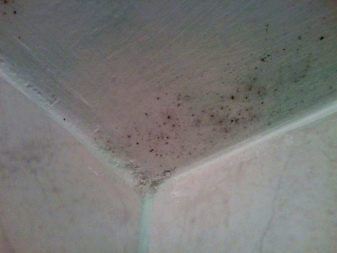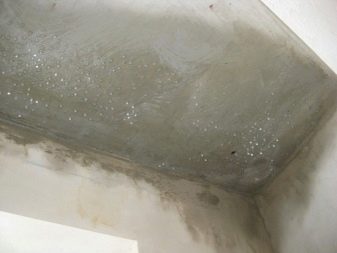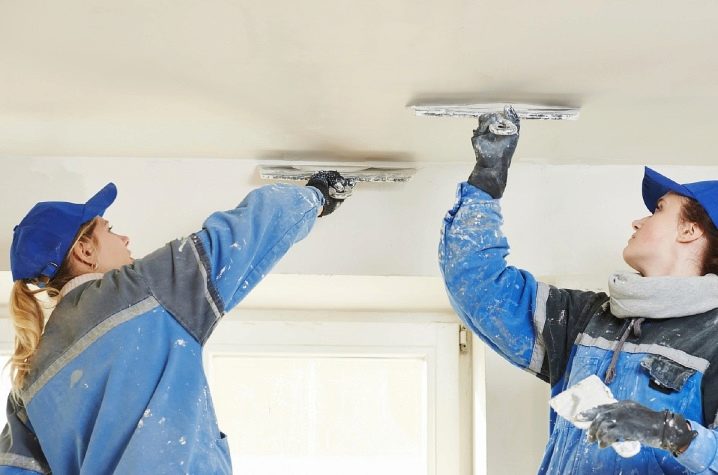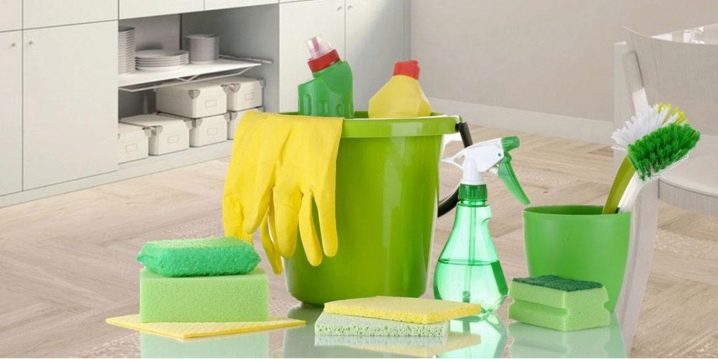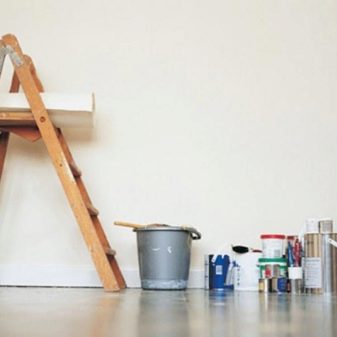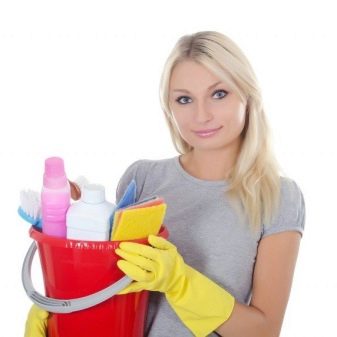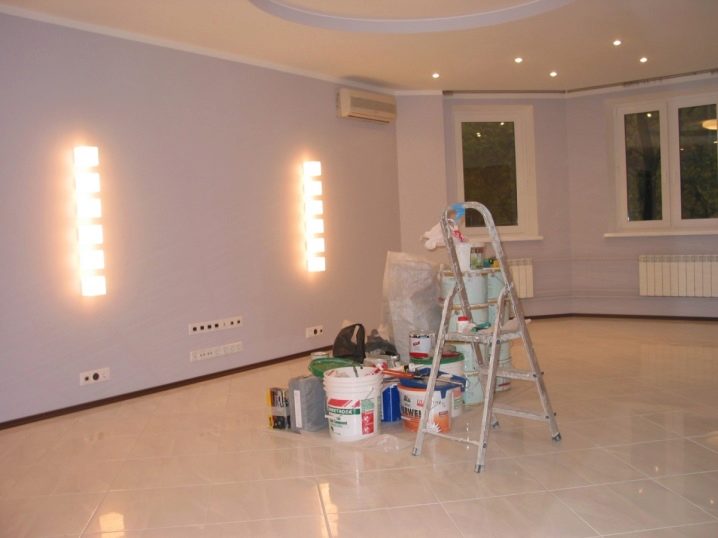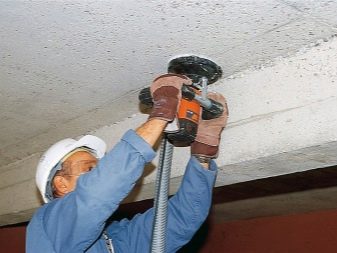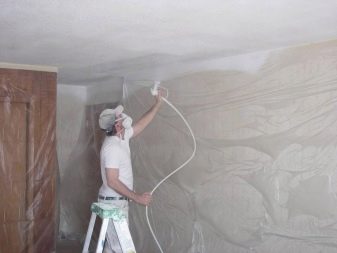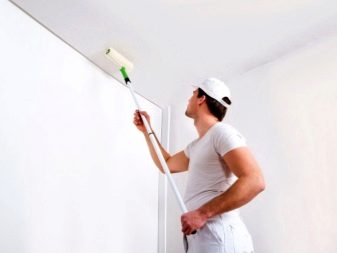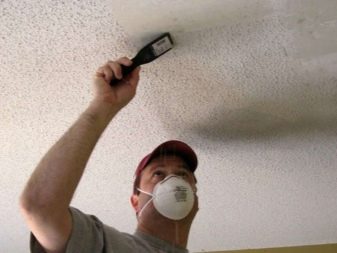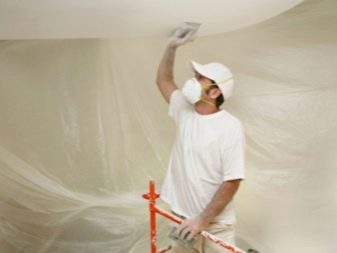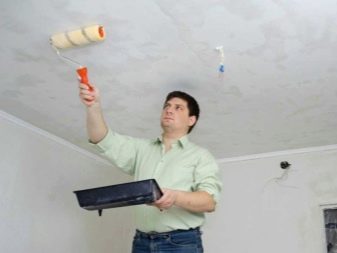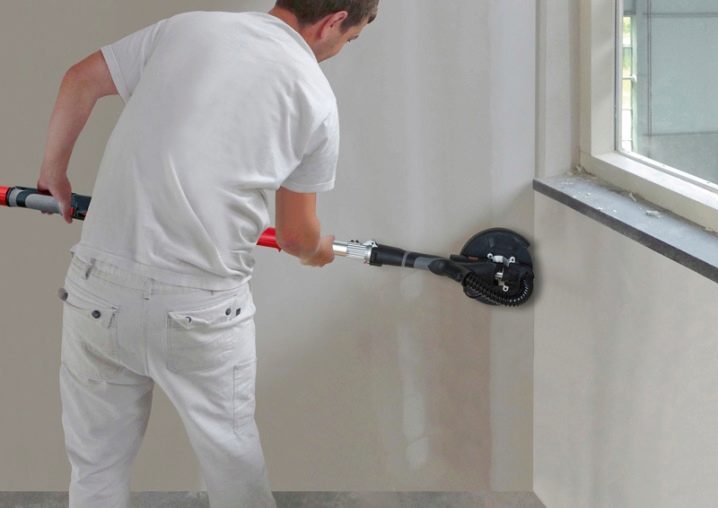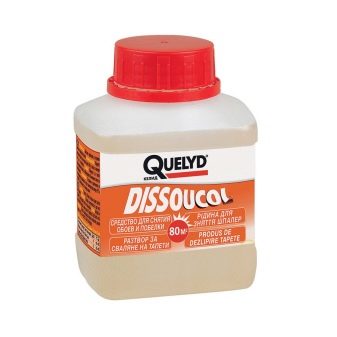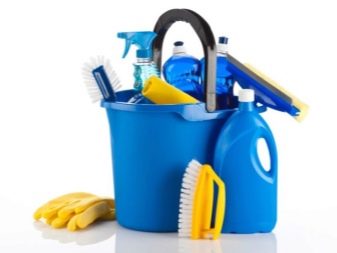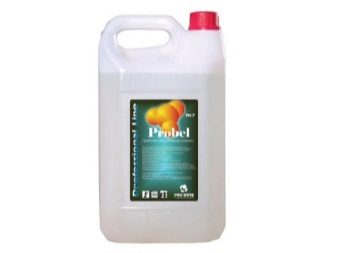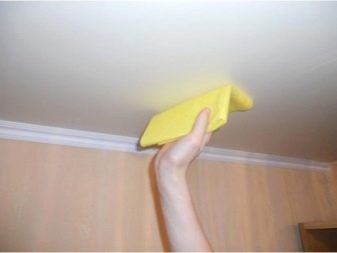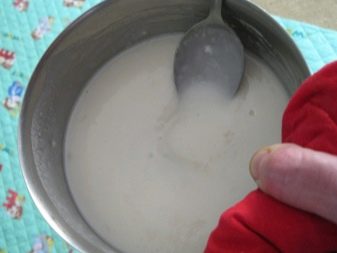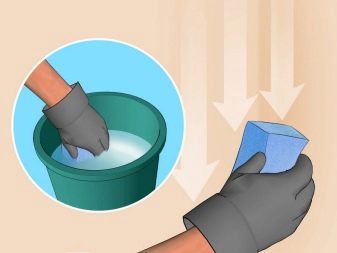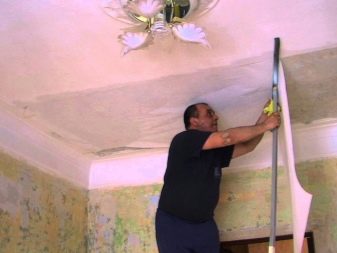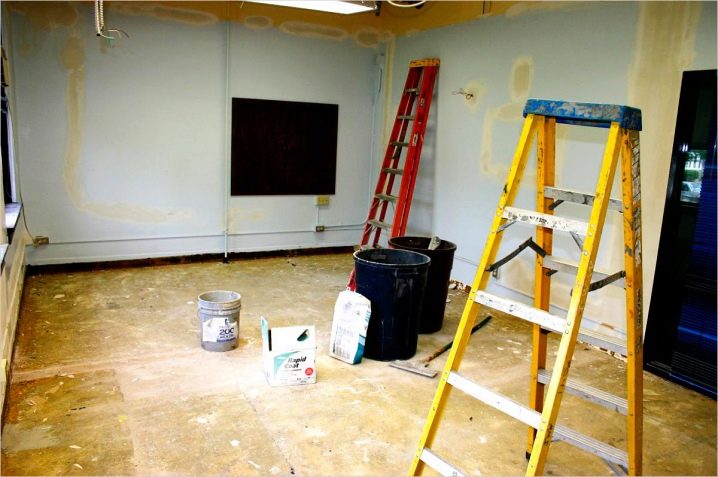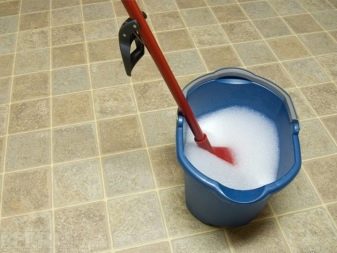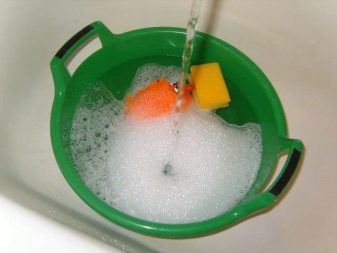How to wash whitewash from the ceiling: ways and means
Quite recently whitewashing was the main surface of the ceiling, now various types of coating are used for this. Making a new repair, in many cases old whitewash is removed from the surface. Given that they remove it from the ceiling, this is not very convenient to do. It is necessary to figure out in what cases wash off whitewashing and in what way it is better to do it.
Peculiarities of pollution
When carrying out repairs, finishing the ceiling pays great attention, because every detail in the interior should emphasize the overall design idea. The upper part of the room should be in harmony with the general style of the room.
Not so long ago only whitewashing was used to finish the ceilings., but in modern design these surfaces began to pay special attention.Hinged ceilings, plasterboard or polystyrene foam plates, decorative plaster, different types of wallpaper, painting - this is not a complete list of how to change the appearance of the ceiling covering of the room and transform it.
In order to prepare the surface for applying paint, sticking wallpaper or other decorative coating, wash the layer of whitewash from the ceiling. It is quite easy to do this, but given that you have to work from the ceiling, the work becomes a bit more complicated. Immediately it should be announced that whitewashing should not always be removed from the surface. For example, this is not done when installing a suspended ceiling or tension structures. You can also whitewash the ceiling again if the old layer is in good condition.
Before applying a new layer of surface clean of dirt, the ceiling is washed with a wet sponge. When applying a new layer, it is taken into account that the previous layer was whitewashed - it may be lime or chalk. When applying a new layer, it should be borne in mind that chalk should be applied to the chalk whitewash, and lime should be applied to the limescale.
To determine which layer was previously, the ceiling is sprayed with water.If water droplets hang on the surface, the ceiling was whitewashed. If water was immediately absorbed into the surface, it means that chalk was used for its whitewashing.
Be sure to remove the whitewash:
- if mold appears on the surface;
- painting with a water-based paint is planned;
- wallpaper will stick;
- if foam polystyrene plates are glued to the ceiling.
Dismantling the ceiling is an important step. If it is wrong or poorly to remove whitewash from the surface, then wallpaper, paint or any other type of finish will not hold well.
Materials and tools
Remove the old layer without dust is unlikely to work, therefore, should be thoroughly prepared for work. Extras and furniture, carpets, and curtains are removed from the room. Bulky items or furniture that are difficult to endure are covered with foil. On the floor should lay a plastic cover, you can decompose and newspapers that will absorb excess moisture.
There will not be a lot of dirt on the walls at work; it is enough to wipe them with a damp cloth. Garbage bags should be prepared in advance in order to quickly remove old newspapers and films after they have been completed.
Such work is rather dirty, so it is better to prepare special clothes, put a kerchief or a cap on your head. Be sure to wear goggles for protection and use a respirator.
In addition to workwear, you should prepare the tools that will be needed during work.
During the work you will need:
- putty knife;
- sponges, rags;
- sprayer for wetting the surface;
- ladder;
- water tank;
- gloves.
If there are no stepladders, a stable table and chair will do, but using them is not always safe.
During operation, doors and windows should be closed to prevent lime dust from entering neighboring rooms. Considering that this work is very dusty, you should put a wet rag on the threshold so that when leaving the room the dirt from the shoes is not carried out of the room.
Of course, this is the main list of necessary tools and preparatory work. A more accurate list of them may vary depending on the state in which the surface.
Ways
After the necessary protective equipment, tools and clothing have been prepared, extra furniture has been taken out of the room, the floor is covered from dirt, and the main work is started.
Washing the ceiling is done dry and wet. For the dry method of washing using a grinder and a spatula. In the wet method, the lime is washed off with water or chemical solutions, household means. With the wet method it is easier to clean the surface, but there will be much more dust in the room, and there is a lot of dirt on the floor.
From what type of whitewash used previously depends on the choice of its method of cleaning. If you hold your hand over the surface of the chalk, a white mark will remain on your hand, there will be no such mark from lime. Often ceilings are painted with water-based paint. When holding the palm on the painted surface of the paint on the hand will not remain.
To make sure that the ceilings are not whitewashed, but emulsion paint, you should wet the sponge and rub a small area. In the first case, there will be no obvious traces of paint on the sponge, and the wall will wash a little.
It is necessary to elaborate on what methods are used to properly and quickly remove whitewash from the surface.
Wet
Old whitewash is removed with water. This method is used quite often.
The following tools should be prepared for it:
- roller - for such cleaning use a device with an attached pallet, where the garbage immediately falls;
- spray;
- rags, rags;
- putty knife.
If you need to remove the old coating, the ceiling is moistened using a sprayer, a wet roller is also suitable for this. Putting water on the surface you need to make sure that it does not flow, therefore, apply it moderately. After 10-15 minutes, the ceiling is moistened a second time.
The old layer of whitewash is removed from the ceiling with a spatula. If the solution drains during operation, it means that the surface was moistened very strongly, you need to wait until the surface dries out a little.
It is more convenient to apply water to the walls and ceiling with a spray. When working with a roller, you can overdo it and the liquid will drip into the face. Moisturize the ceiling evenly so that the whitewash can be removed from the surface in one layer. Often during the work they moisten the ceiling on one part, then they move to another part and continue to work there, during which time the whitewashing will become saturated enough with moisture.
Work doing standing on a ladder. Before starting it, you should make sure that the ladder is stable. It is good, if at this time there is a helper nearby who will insure that the stepladder does not falter.
Using a spatula, remove a thin layer from the ceiling.When all the whitewash is removed from the surface, take a wet sponge to wash away the remnants of the layer. When the ceiling is dry, check how well the work was done. To do this, hold the palm across the ceiling. If there are no whitewash traces on it, then the work was done perfectly.
Sometimes for this method, the spatula is not used. When a thin layer of whitewash it is removed using a wet cloth. The most economical option can be called washing the surface with plain water. This cleaning will be the cheapest, although with this method it will be necessary to apply physical force.
Water is poured into a bucket, rags and brushes are taken and the whitewash is washed from the ceiling. When flushing with water, wash the instrument more often and change the water. To work was less time consuming, the liquid is better to use warm. It is difficult to clean chalk and whitewash from the ceiling using this method, especially since during the work the chalk solution will always get on the face, and this makes the work very difficult. Use this method better on the ceiling with a thin layer of paint.
This method has a drawback - unfortunately, one cannot do without dirt here. In addition, completely remove the entire layer from the surface in this way will not succeed.As already mentioned, you should cover the floor with plastic wrap or newspapers. This will significantly reduce the time for cleaning the room after work.
Spatula
To remove whitewash from the ceiling, use a spatula.
For this method you need to prepare:
- spatulas - 2 pieces, wide and narrow;
- sandpaper;
- rubber mallet;
- a vacuum cleaner.
When starting work, you should inspect the surface. With the help of a rubber hammer, knock the ceiling and reveal places with a weak grip. If the rubber hammer is not at home, you can try to work by knocking the surface with the handle of an ordinary trowel.
Places where the old whitewash is already poorly kept, hooked with a narrow trowel. Use a wide trowel to clean the surface, taking care not to damage the putty during operation. It is much more convenient to work, if you put something like a scoop under the spatula, then all the whitewash will remain there, and will not fall down.
This method can be slightly improved. and independently make a device for cleaning the surface. A hole is drilled in the spatula, wire or braid is passed through it and the bath is hung, where all the dirt will fall.
At the final stage with the help of emery paper, the remains are removed and the surface is cleaned. Then you can go vacuuming and easily remove dust from the ceiling. After that, the surface should be washed with a damp sponge or brush it.
When working with a spatula in the room will be a lot of dirt and dust, so it is important to prepare in advance the means to protect the respiratory tract.
Special means
You can remove the whitewash from the walls or ceiling using special tools that are sold in the hardware store.
Working with them is very simple, for this you should:
- spray onto the surface;
- when the surface is covered with a crust, whitewashing is removed very easily;
- mop with a spatula.
Using this method, there will be practically no dust, but there will be enough dirt. In order to remove the old whitewash, such popular tools as Metylan and Quelyd Dissoucol. With their help, chalk and plaster whitewash is removed, and the tool is suitable for removing dust. Probel.
Means Metylan diluted with water 1 to 10 and applied to any surface, then cleaned with a spatula. Means Probel often used during repairs. To do this, a damp sponge diluted with water means is applied to the surface. After the layer is softened, whitewash is removed with a spatula.
Means Alfa choose to remove whitewash and to clean the room after the repair. Using these products, you can quickly get rid of traces of repair. They do not leave on the surface of stains and whiteness. Work with concentrates should be in gloves and protective glasses. Diluted product in proportions from 1: 10 to 1: 100 and put it on the surface.
The washes that are sold in the store are very concentrated, so they are enough to handle a large surface. When choosing special tools, it should be noted that they are not cheap, so it is worthwhile to include them in advance in the estimated costs for repairs. In addition, there are cases of falsification of these funds, so they are best purchased in specialized stores, and not on the market or in another similar place.
Use grinding machine
Grinding machine is used to remove whitewash or water emulsion, if they are poorly removed with a spatula. Treat the surface better in small areas. For those who are not familiar with the operation of the grinding machine, you should read the instructions and make a small sample on the surface to evaluate the result. Using a spatula, you can clean out hard-to-reach areas.
For work take:
- angle grinder;
- a vacuum cleaner;
- putty knife;
- personal protective equipment: special goggles, respirator or mask.
When you connect the grinder to a vacuum cleaner, you can immediately remove all the dust. To clean the surface, they take sandpaper, immediately clean the ceiling with sandpaper with a large abrasive, then transfer to a shallow one. After work is finished, dust is removed from the surface. To do this, take a sponge, soft cloth or brush. After processing the surface should be primed.
Working with a grinder, quickly and simply get rid of the layer of whitewash will not succeed, it is a difficult process, besides in the room there will be a lot of dust and dirt. Chalk whitewash is better to remove the wet method. After all the manipulations, the ceiling will be almost completely ready for further repairs.
With glue
To get rid of whitewashing on the surface, you can use glue or paste.
This method is suitable for those who do not want to mess around with washing out the dirt.
For this method you need to take:
- a stack of old newspapers;
- roller or brush;
- paste that can be replaced with inexpensive wallpaper glue.
Before you start, you should prepare a paste. For its preparation will need starch.It is diluted with a little water and set on fire. Klester bring to a boil, constantly stirring. After cooling, it is ready for use.
Old newspapers inflict brewed paste. They smear the whole newspaper with them, leaving only the corners dry. Wet newspaper stick to the surface and wait until it dries. Pulling the dry corners of the newspaper, you can quickly and easily remove them from the ceiling along with a layer of whitewash. If there are places with remnants of glue or whitewash, they are removed with a mop, which is wrapped in a damp cloth.
Instead of paste, which is brewed independently, you can take the usual cheap wallpaper glue and use it in the previously described method. Glue or brewed paste must be completely dry, otherwise it will be more difficult to remove the whitewash from the ceiling.
Useful tips
Starting repair work, you should observe safety precautions and work using protective equipment. Special attention should be paid to the fact that lime and other materials can get into the eyes, thereby causing a burn or other damage to the cornea. It is necessary to work only in special protective glasses!
Such repairs suggest that there will be a lot of dust in the room, so a respirator or gauze bandage must be present to protect the airways.
It is important to note that washing the whitewash from the ceiling can wet the wiring, so turn off the lights during work. If the light is not enough, the right places are highlighted with a flashlight or carrying.
If there is no special wash on hand or it is impossible to use any of the methods described above, you can use a homemade mix.
For a homemade wash you need:
- type in a bucket 5 liters of water;
- add 5-6 caps of bath foam and 1 tbsp to the water. a spoonful of vinegar;
- this soap-acetic composition process small areas of the surface;
- wait 5 minutes for the surface to clear;
- using a spatula to strip the ceiling;
- when the work is finished, wash the ceiling with warm water.
When working with a homemade remover, be sure to put old newspapers or any oilcloth on the floor, as there will be plenty of dirt.
You can use another method that does not require a special investment of money - using ordinary salt. Table salt is added to warm water. For 10 liters of water should take a pack of salt in 1 kg. Such a homemade wash will be very cheap, and the result will be no worse than using other means. You can easily and effortlessly clean the ceiling from whitewashing.
Self-made mixes will be much more economical than purchase options. One of the old ways that was used to remove traces of whitewash from the ceiling is the use of a solution with soap. For the solution take soap, which does not contain dyes or other additives. In this case, it will be better to remove the whitewash from the ceiling and walls. In a small bucket (5 liters) with warm water, add a spoonful of baking soda and 2 or 3 spoons of laundry soap.
Such a mixture can cope with any contamination and wash off not only whitewash, but also dirt from the surface, so it will not be necessary to spend money on the purchase of expensive detergents.
After the repair work is difficult to get rid of traces of whitewash on the floor. Even if an oilcloth, plastic wrap or newspapers are placed on the floor, there is a high probability that the floor will still become dirty. It is possible to wash the whitewash from the floor by wiping it with water and vinegar; if very dirty, the floor should be washed at least three times.
Applying any of these methods, you can get rid of whitewashing on the ceiling. Each of them has its advantages and disadvantages.Which one of them to apply - each decides individually, this may depend on the means that are available, and on some other conditions.
How to wash whitewash from the ceiling, see the video below.
